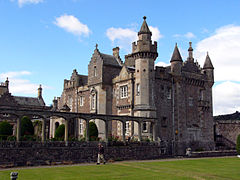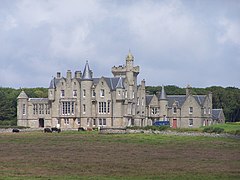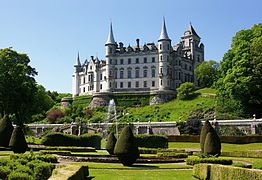Scottish Baronial
Scottish Baronial (also Scots Baronial or Scotch Baronial ; German Scottish Baroniestil ) is a historicist architectural style that developed in Scotland in the 19th century . It was based on the fortified architecture of the Tower Houses from the late 16th and early 17th centuries and was the Scottish variant of the neo-Gothic style that was widespread throughout Europe at the time .
Features of the style are large mansions and castles in the country, the interior of which corresponded to the technical standard and comfort requirements of the 19th century, while their exterior gave the impression of a manor house from the 16th / 17th century. Century mediated. For this purpose, the architects mainly used elements such as roofs of different heights, battlements , towers with watch towers , stepped gables and lancet windows , whereby the defensive elements no longer had any military tasks, but only served to decorate the building.
The development of the style was facilitated by a social trend which - inspired by the works of the Scottish writer Sir Walter Scott - had rekindled interest in a Scottish identity of its own. Scotland was no longer to be just “Northern Great Britain”, and so the original Scottish style, such as the castle architecture of Scotland, was remembered . It was also Scott for whom Abbotsford House was built, a manor house whose style was a forerunner of the Scottish Baronial.
At the beginning of the 19th century, James Gillespie Graham designed numerous buildings in the style of the Scottish Baronials, whereby, in contrast to his later representatives, he was more oriented towards medieval sacred buildings than castle architecture. Around 1830, William Burn (1789–1870) took up the style and developed it further. His student and later partner David Bryce (1803–1876) became the most famous representative of the Scottish Baronials. Craigends House (1857) and Balfour Castle , built from 1846 to 1850, were based on his plans . Another example of this style is Dunrobin Castle , which was expanded from 1844 by Charles Barry for the second Duke of Sutherland . Probably the most famous building, however, is Balmoral Castle , which the British Queen Victoria had built as a summer residence in the Highlands between 1853 and 1856 .
- Examples of Scottish Baronial
literature
- Blaikie Murdoch flat share: Scottish Baronial. A Noble Style in Architecture . In: New Blackfriars . Volume 10, No. 116, November 1929, ISSN 1741-2005 , pp. 1436–1443, doi: 10.1111 / j.1741-2005.1929.tb05481.x .
- Miles Glendinning, Aonghus MacKenzie: Scottish Architecture . Thames & Hudson, London 2004, ISBN 0-500-20374-1 , pp. 131-134, 141-146.
Web links
- Scottish Baronial on buildinghistory.org (English)
- About David Bryce and Scots Baronial (English)
Individual evidence
- ^ A b M. Glendinning, A. MacKenzie: Scottish Architecture , p. 141.
- ↑ Style information on undiscoveredscotland.co.uk , accessed December 30, 2019.
- ↑ Information on the architectural style with five example buildings ( Memento from November 9, 2005 in the Internet Archive )
- ↑ Scottish Baronial on buildinghistory.org , accessed December 30, 2019.



